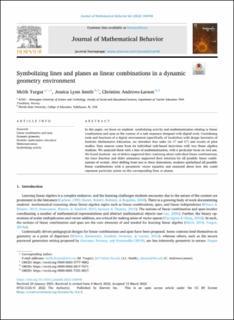| dc.contributor.author | Turgut, Melih | |
| dc.contributor.author | Smith, Jessica Lynn | |
| dc.contributor.author | Andrews-Larson, Christine | |
| dc.date.accessioned | 2022-03-29T10:54:56Z | |
| dc.date.available | 2022-03-29T10:54:56Z | |
| dc.date.created | 2022-03-23T08:50:27Z | |
| dc.date.issued | 2022 | |
| dc.identifier.citation | Journal of Mathematical Behavior. 2022, 66 1-20. | en_US |
| dc.identifier.issn | 0732-3123 | |
| dc.identifier.uri | https://hdl.handle.net/11250/2988285 | |
| dc.description.abstract | In this paper, we focus on students’ symbolizing activity and mathematization relating to linear combination and span in the context of a task sequence designed with digital tools. Considering tools and functions of a digital environment (specifically of GeoGebra) with design heuristics of Realistic Mathematics Education, we introduce four tasks (in R2 and R3) and results of pilot studies. Data sources come from six individual task-based interviews with two linear algebra students. We analyzed these with a lens of mathematization, with a particular focus on tool use. We found students’ use of sliders supported their reasoning about individual linear combinations; the trace function and slider animation supported their intuition for all possible linear combinations of vectors. After shifting from two to three dimensions, students symbolized all possible linear combinations with a parametric vector equation and reasoned about how this could represent particular points on the corresponding lines or planes. | en_US |
| dc.language.iso | eng | en_US |
| dc.publisher | Elsevier | en_US |
| dc.rights | Navngivelse 4.0 Internasjonal | * |
| dc.rights.uri | http://creativecommons.org/licenses/by/4.0/deed.no | * |
| dc.subject | Matematikkdidaktikkk | en_US |
| dc.subject | Mathematics didactics | en_US |
| dc.title | Symbolizing lines and planes as linear combinations in a dynamic geometry environment | en_US |
| dc.type | Peer reviewed | en_US |
| dc.type | Journal article | en_US |
| dc.description.version | publishedVersion | en_US |
| dc.subject.nsi | VDP::Fagdidaktikk: 283 | en_US |
| dc.subject.nsi | VDP::Subject didactics: 283 | en_US |
| dc.source.pagenumber | 1-20 | en_US |
| dc.source.volume | 66 | en_US |
| dc.source.journal | Journal of Mathematical Behavior | en_US |
| dc.identifier.doi | 10.1016/j.jmathb.2022.100948 | |
| dc.identifier.cristin | 2011847 | |
| cristin.ispublished | true | |
| cristin.fulltext | original | |
| cristin.qualitycode | 2 | |

